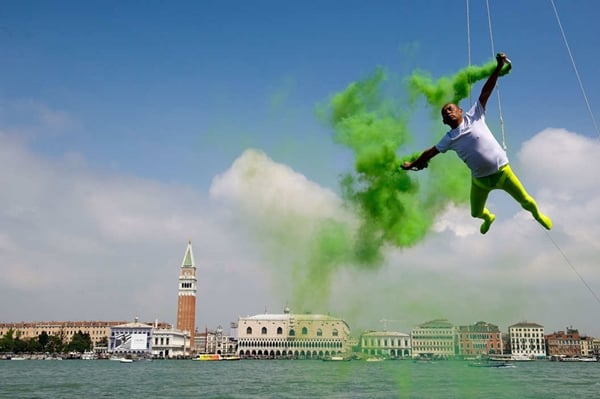
Central Pavilion La Biennale.
Photo: G. Zucchiatti, courtesy by la Biennale di Venezia.
What is it?
The Venice Biennale is one of the most important international contemporary art exhibitions. Founded in 1895 by the Italian King Umberto I and Queen Margherita de Savoia, the exhibition was originally held solely in the Padiglione Italia at the Giardini, which was renamed the Central Pavilion in 2009. Since its expansion, the Giardini also hosts an additional 30 national pavilions, built by participating countries themselves. Everyone in the art world, it seems, descends on the city for this event for the art, the schmoozing, and the chance to travel to one of the most beautiful and art historically rich sites in the world. Here’s a tip sheet on what to do when you get there.
Joan Jonas, Mirror Check (1970).
Photo: Courtesy of the Brooklyn Museum.
Which artist will represent your country?
There will be 136 artists representing 88 national participants in the 56th edition of the exhibition. Eighty-eight artists coming from 53 different countries will show for the first time in Venice. Of the works on display, 159 are specifically fabricated for the event and have never been exhibited before. Before you arrive, make sure to find out which artist will be representing your country’s pavilion, see the full list here.
Danh Vo, We the People.
Photo: via Contemporary Art Daily.
Which pavilions should be on your short-list?
Joan Jonas will be representing the United States this year. In the five galleries of the pavilion, the American artist will create new works, incorporating video, drawings, objects, and sound. Extending her investigation of Icelandic writer Halldor Laxness, Jonas will also look to other literary influences whose writing centers on nature and spirituality.
Philip Rizk, Olaf Nicolai, Hito Steyerl, and Tobias Zielony will be representing Germany. The four artists incorporate video, performance, and photography that all highlight the themes of “work,” “migration,” and “revolt”. (See Hito Steyerl’s Artists Space Show Mixes, Money, Violence, and Art and Delights The Mind).
Danh Vo will represent Denmark and he will also be curating an exhibition at Venice’s Punta della Dogana. The Danish artist produced limited edition artisanally produced bottles of tequila (see Danh Vo Brings Tequila to Venice for First Artist-Curated Punta della Dogana Exhibition).
The Belgium pavilion will be worth a look. Instead of focusing on nationality and its representative artist, Vincent Meessen, the space will also feature guest artists from Africa, Asia, and the Americas to explore the notions of “internationalism” and “solidarity.”
Swiss Artist Christoph Büchel with The Icelandic Art Center and the Ministry of Education, Science, and Culture of Iceland will collaborate with the Muslim communities in Venice and Iceland to create the city’s first Mosque inside the Icelandic pavilion, the 10th century church of Santa Maria della Misericordia.
In conjunction with Christodoulos Panayiotou’s presentation for the Cyprus Pavilion, two performances will be staged during the opening days of the exhibition: The Parting Discourse, which will happen between the stage of the Teatro Goldoni and the Cyprus Pavilion, and Levant U-Turn, for which participants will dive into the Mediterranean. The performances will kick off a series of activations that will happen throughout the summer.
Front entrance of the new Australian Pavilion, at the Venice Biennale, designed by Denton Corker Marshall.
Photo: John Gollings, courtesy the Australia Council for the Arts.
What’s new?
This year, the Biennale will start one month before its usual open date.
Australia has built a pavilion, making it the 30th national pavilion to be built in the Giardini, and the first one to be erected in the 21st century (see Australia Unveils New Venice Biennale Pavilion).
Curator and director, Okwui Enwezor is introducing a new section called ARENA, an interactive space within the Central Pavilion of the Giardini devoted to live programming across an array of disciplines. The centerpiece of the events in the ARENA will be a reading of Karl Marx’s Das Kapital, which will be read over the course of the seven months of the exhibition. Also happening in the space, designed by starchitect David Adjaye, will be a temporary memorial for African American musician and composer Julius Eastman created by Mathieu Kleyebe Abonnenc, as well as a new performance work by Olaf Nicolai inspired by the tapes of Italian composer Luigi Nono.
Corderie.
What’s happening at the Arsenale?
The Arsenale, a former military complex for the Italian navy, is a place where visitors can view up to 200 young artists whose national origin is not represented in the permanent pavilions. This year’s Arsenale exhibition will be curated by Okwui Enwezor and will feature works by artists such as Jennifer Allora and Guillermo Calzadilla (see Venice Biennale Curator Okwui Enwezor On “All the World’s Futures,” Karl Marx, and The Havana Biennial Boycott). The duo will be doing several performances inspired by Joseph Haydn’s oratorio The Creation.
Okwui Enwezor and Paolo Baratta.
Photo via: Design Boom
What collateral events should you go to?
There will be 44 events (approved by curator Enwezor) happening alongside “All the World’s Futures.” Not to miss is the collaboration between Indian artist Shilpa Gupta and Pakistani artist Rashid Rana, who will exhibit along side each other in a 17th century palazzo in a work titled My East is Your West.
Simon Denny, representing New Zealand, will do a sculptural installation that plays upon the idea of political power relations, and his work will take to two locations: the Venice airport and the Marciana Library on the Piazza San Marco (see Simon Denny Insists Art Is a Place Where People Want Substance and Depth).
New work by Peter Doig will be on view at the Palazetto Tito at Fondazione Bevilacqua La Masa. And a Cy Twombly exhibition of 60 of his paintings (including four of his last), will be on view at the Spazio Dom Perignon of Ca’pesaro International Gallery of Modern Art.
The 56th Venice Biennale “All The World’s Futures” will run from May 9 through November 22, 2015.